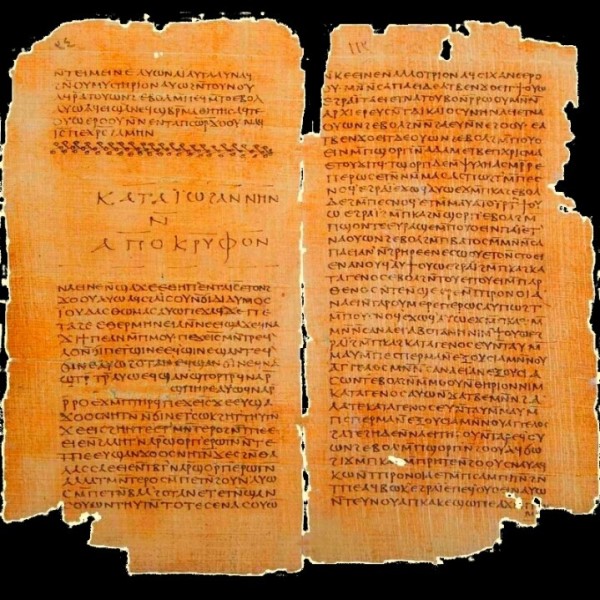THE GOSPEL OF THOMAS 도마 복음서
I: CommentaryI: 도마복음 주해
The Gospel of Thomas is a collection of traditional Sayings (logoi) of Jesus. It is attributed to Didymos Judas Thomas, the “Doubting Thomas” of the canonical Gospels, and according to many early traditions, the twin brother of Jesus (“didymos” means “twin” in Greek).도마 복음서는 전승되어 온 예수의 말씀들의 모음이다. 이 복음서는 디디모스 유다 도마 (Didymos Judas Thomas)의 작품으로 여겨지며, 그는 정경 복음서들에 나오는 “의심하는 도마”이다 그리고 많은 초기 전승들에 의하면, 그는 예수의 쌍둥이 형제이다(“didymos”는 그리스어로 “쌍둥이”를 의미한다.).
We have two versions of the Gospel of Thomas today. The first was discovered in the late 1800’s among the Oxyrhynchus Papyri, and consists of fragments of a Greek version, which has been dated to c. 200. The second is a complete version, in Coptic, from Codex II of the Nag Hammadi finds. Thomas was probably first written in Greek (or possibly even Syriac or Aramaic) sometime between the mid 1st and 2nd centuries.오늘날 우리는 두 가지 버전의 도마복음서를 볼 수 있다. 첫째 것은1800년대 후기에 옥시린쿠스 파피루스 가운데서 발견되었으며, 그리스어 버전의 파편으로 되어있으며, 약 기원 200년경으로 알려졌다. 둘째 것은 완전한 버전으로, 나그 함마디 유물 중의 코덱스II로부터 나왔으며, 콥틱어로 되어있다. 도마서는 필시 1세기 중엽 및 2 세기 사이에 처음에는 그리스어 (혹은 필시 심지어 시리아어 혹은 아람어)로 쓰여졌을 것이다.
There has been much speculation on the relationship of Thomas to the canonical Gospels. Many Sayings in Thomas have parallels with the New Testament Sayings, especially those found in the synoptic Gospels. This leads many to believe that Thomas was also based on the so-called “Q” Document, along with Matthew, Luke, and Mark. Indeed, some have speculated that Thomas may in fact be “Q”. Unlike the synoptic Gospels, and like “Q”, the Gospel of Thomas has no narrative connecting the various Sayings. In form, it is simply a list of 114 Sayings, in no particular order. Comparison with New Testament parallels show that Thomas contains either more primitive versions of the Sayings, or developments of more primitive versions. Either way, Thomas seems to preserve earlier traditions about Jesus than the New Testament.도마서의 정경 복음서들에 대한 관계에 관해 많은 추론들이 있어왔다. 도마서에 있는 많은 말씀들은 신약성서의 말씀들, 특히 공관 복음서 안에 있는 것들과 유사하다. 이러한 연유로 많은 사람들은 도마서 역시 마태, 누가, 및 마가 복음서와 함께 소위 “Q” 문서를 바탕으로 한 것이라 믿는다. 사실 어떤 이들은 도마서가 “Q”일 것이라 추론한다. 공관 복음서들과는 달리, 그리고 “Q”와 같이, 도마서는 여러 말씀들을 연결하는 서술이 없다. 형식에 있어서, 단순히 114개 말씀의 목록이며, 특정한 순서도 없다. 신약성서와 대응하는 비교에 의하면 도마서는 좀더 원시적인 버전의 말씀들 혹은, 좀더 원시적인 버전들로 만든 새로운 내용들을 담고 있다. 어느 쪽이든, 도마서는 신약성서보다 더욱 초기의 예수의 전승들을 보존하고 있는 것 같아 보인다.
Although it is not possible to attribute the Gospel of Thomas to any particular sect, it is clearly Gnostic in nature. As the preamble indicates, these are “secret sayings”, and are intended to be esoteric in nature. The Sayings are not intended to be interpreted literally, as their New Testament parallels often are, but to be interpreted symbolically, as attested by Saying #1. While a literal interpretation may make sense, only by understanding the deeper meanings of the Sayings can one truly understand them. Thus in Saying #114, it is to be understood that “male” symbolizes the pneumatic (spiritual, or Gnostic) Christians, and “female” symbolizes the psychic (unenlightened, or orthodox) Christians, rather than actually referring to males and females. Keep in mind that true understanding of this text was meant to come from PERSONAL contact with the Divine, inspiration from within.비록 도마 복음서를 어떤 특정 분파의 것으로 돌리는 것은 가능하지 않지만, 분명 성격에 있어서 영지적이다. 서문에서 가리키듯, 이 말씀들은 “비밀의 말씀들”이다, 그리고 성격에 있어 은밀하다. 이 말씀들은 대응하는 신약성서에서 그랬듯, 문자 그대로 해석함이 아니라 [제 1장]에서 증거하듯 상징적으로 해석하도록 의도되어 있다. 직설적 해석도 의미는 와 닿지만, 오직 말씀들에 대한 더욱 깊은 의미들을 이해함으로써 우리는 진정 깨달을 수 있다. 그러므로 [제 114 장]의 “남성” 및 “여성”은 실제 남자들 및 여자들을 언급함이 아니라, “남성”은 영적인 (영적, 혹은 영지적) 그리스도인들로, 그리고 “여성”은 혼적인 (깨닫지 못한, 혹은 정통파적) 그리스도인들 이해되어야 한다. 이 원문의 참된 깨달음은 하나님과의 인격적 접근, 안에서 나오는 영감으로부터 비롯되게 되어 있음을 유념해야 한다.
I will now present translations of both the Greek and Coptic versions of the Gospel of Thomas. Of the 114 Sayings in the complete work, and all of the fragments of the Greek text. Also, the Greek version contains one Saying not found in the Coptic version, which comes between Sayings 32 and 33 of the Coptic version. I will enter the Coptic version first, as it is more complete, followed by the Greek version. After both translations, I’ve provided a listing of New Testament parallels for all 114 sayings for easier comparison.나는 이제 그리스어 및 콥틱어 버전의 도마 복음서의 번역본을 제시하고자 한다. 114개의 말씀들에 대한 완역 본, 및 그리스어 원문의 파편들에 대한 모두를 제시한다. 또한, 그리스어 버전은 콥틱어 버전에서 발견되지 않는 한 가지 말씀을 담고 있으며, 이는 콥틱 버전 32와 33의 말씀들 사이에 나온다. 나는 콥틱어 버전을 먼저 내놓고, 다음으로 그리스어 버전을 놓을 것이다. 두 가지 번역들 뒤에, 쉬운 비교를 위해 114개 말씀들 모두에 대한 신약성서의 대응 목록을 제시하였다.
Note that for the Coptic version, I use the standard NHL translation, except for saying 70, where I have substituted the translation found in Elaine Pagels’ “The Gnostic Gospels”, as it seems a better translation.참고할 것은, 콥틱 버전을 위해 나는, 70장의 말씀을 제외하곤, 표준 NHL 번역본을 사용한다. 70 장의 경우 Elaine Pagel의 “영지 복음서들”에 있는 번역본으로 대체했으며, 더 나은 번역으로 보이기 때문이다.
Peace & Enlightenment be yours!평화와 깨달음이 당신에게 있기를!
IA: Editorial SymbolsIA: 편집자 기호들
I have followed the Nag Hammadi Library standard for typographical symbols in this file. Text contained within [square brackets] indicates a damaged portion of the manuscript where the translators have attempted a reconstruction. Text within (parentheses) indicates comments or text added by the translator for clarification purposes. Text within indicates a scribal error (spelling, grammatical, etc) in the original, where the translator has made a correction. Text within {funky brackets} indicates superfluous text added by the scribe.나는 이 파일 안에서 인쇄용 기호로 나그 함마디 장서 표준을 따랐다. [대괄호] 안에 든 자구는 번역자들이 복구하려 시도했던 원고의 손상된 부분을 가리킨다. (둥근괄호) 안의 자구는 설명의 목적으로 번역자에 의해 첨가된 주석 혹은 자구를 가리킨다. <꺾쇄괄호> 안의 자구는 원본에 포함된 필경자 오류 (철자, 문법, 등)로, 번역자가 교정을 한 것이다. {중괄호} 안의 자구는 필경자가 첨가한 잉여 자구를 가리킨다.


 LDTV.KR
LDTV.KR
















